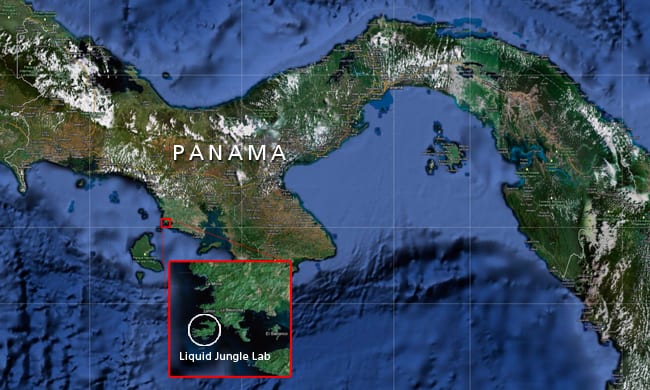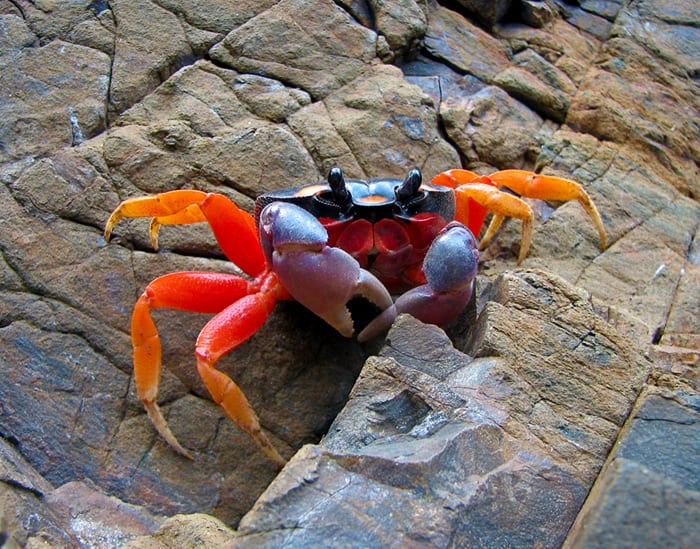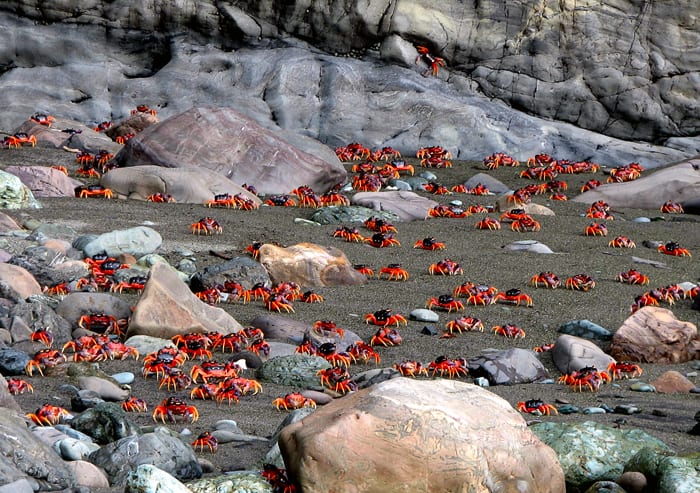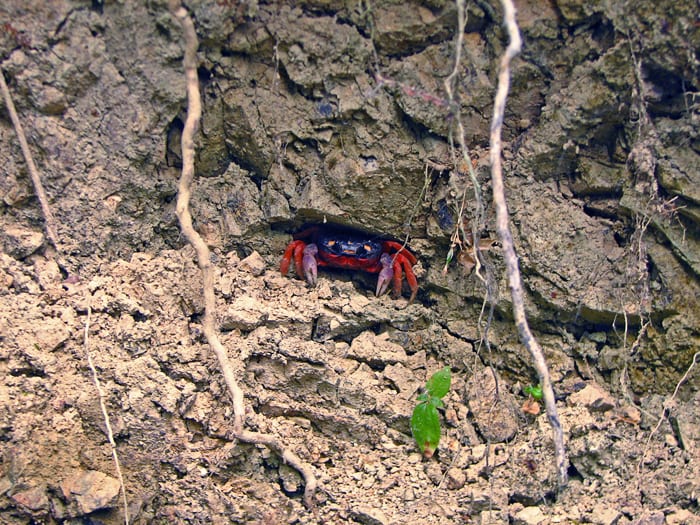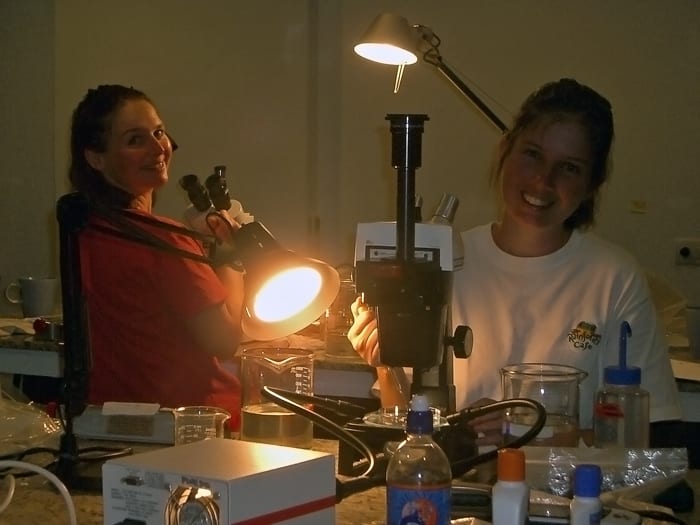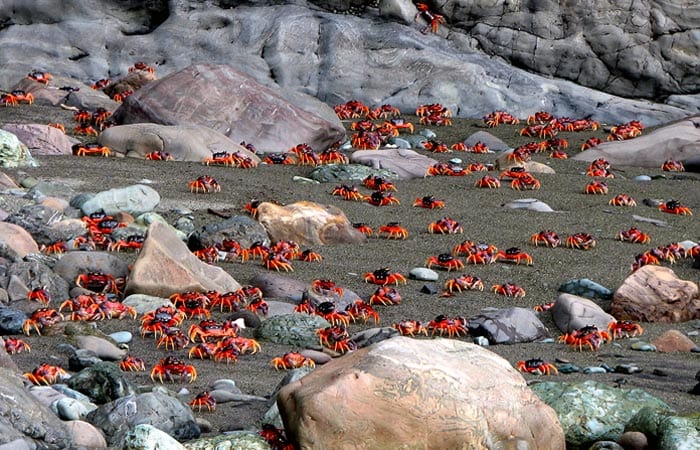
A Torrent of Crabs Running to the Sea
A student uncovers the natural history of a little-known species
Joanna Gyory’s Ph.D. plans changed completely when she saw the crabs. It was her third or fourth day at the Liquid Jungle Lab, a research facility on an undeveloped island off Panama’s Pacific coast.
After a dry season lasting several months, it started to rain. After the rain, like a scene from a 1950s science-fiction movie, mobs of bright red-and-purple crabs emerged and ran down to the shoreline, swarming over the entire beach, crawling over rocks and anything else in the way.
“I had no idea these crabs even existed, and then all of a sudden there were thousands of them, all running down towards the water!” she said. “And they are bright red. They’re very visually striking. It was a feeling of wonder. This was so interesting that I wanted to figure out who they were and what they were doing.”
The crabs, Gecarcinus quadratus (“square land crab”) live along Pacific coasts from Mexico to Peru. About four inches claw-to-claw, they are abundant, and local residents certainly knew about them. A native Spanish speaker, Gyory got tips from local residents, who told her they saw the crabs in the rainy season. They told her where she could find them, what the crabs ate, and that people sometimes ate the crabs.
The brilliantly colored adults had been described and named in 1853, but a search of scientific papers told Gyory that no one knew anything about the life cycle of the species—how it reproduces and how it develops from an egg in the ocean to an adult crab on land.
“The coasts of Central and South America in particular have not been studied nearly as well as temperate ecosystems in the northern hemisphere, and many species are still unknown to science,” she said.
Every year, scientists find hundreds of previously unknown species. Discovering them is the easy part. The next step—learning the species’ behaviors and the roles they play in their surroundings—requires painstaking, time-consuming observation, which sometimes isn’t done for more than a hundred years.
This branch of science, known as natural history, may seem like a quaint relic from the era of Charles Darwin in the1800s. Not so, Gyory said. “Natural history is important in the 21st century. We humans are rapidly altering the environment on a global scale without understanding how it might affect organisms and their interactions with their environment.”
Gyory had found her Ph.D. project: to uncover the life history of Gecarcinus quadratus.
Called to the tropical ocean
Gyory was born in Venezuela and lived there her first 10 years, and then moved to Miami with her family—her father, an architect, her mother, a teacher, and her two brothers. In one way, she was already preparing to study marine crustaceans.
“In Venezuela my family would take trips almost every weekend to the beach, and I remember running around looking at logs with barnacles all over them, trying to figure out what all those animals were,” she said.
She studied biology at Cornell, then worked at the University of Miami, where she read a study by Woods Hole Oceanographic Institution biologist, Jesús Pineda. It was about how marine larvae are moved around by currents and waves, and it intrigued her. She went on to earn a master’s degree in marine and atmospheric science at Stony Brook University, and when it came time to pursue a Ph.D., “I thought Jesús’s paper was so interesting that I really wanted to come work with him,” she said, “so I decided I would apply to the MIT/WHOI Joint Program.” Pineda became her advisor.
Pineda studies internal waves—waves moving within the ocean, beneath the surface—and how they transport and distribute marine larvae and other animal plankton along coasts. Gyory planned to study how internal waves affect zooplankton off the coast of the Liquid Jungle Lab. But then the crabs came out.
Zoea and megalopa
A Cheshire-cat kind of animal, the square land crabs are there and not there at the same time. During the long dry season, they are invisible. “Desiccation is a real threat to them,” said Gyory. Tucked into burrows in the forest floor, they come out seldom and only at night, to gather leaf litter that they carry back to eat in their burrows.
And then one day it rains.
“They’ll mate on the first rainfall, and by the second rain they’ll come down to the ocean and release their eggs,” Gyory said. “It rains once or twice a week. Reproduction continues through the season, but the biggest emergence from burrows and migration happens right at the beginning of the rains.”
Other tropical land crab species show similar behavior, Gyory learned: Adults mate in the rainy season and migrate to the sea, where females deposit millions of fertilized eggs in the water over the course of a few weeks.
Like butterflies or frogs, crabs go through stages before reaching adult form. The eggs hatch into larvae called zoea that spend about a month in the ocean as tiny swimming plankton. They develop through a few successive zoea stages and then into a second swimming larval stage called megalopa, and later into small juvenile crabs that move onto land, where they will mature into adults. Adults remain on land throughout their lives, which can be a decade long.
Light traps in the night
To tell Gecarcinus quadratus’ life story, Gyory needed to complete the circle—to show that adult migration was linked to rains, reproduction, and the sea, and to show how planktonic eggs became terrestrial adults.
Gyory read scientific studies of other land crabs and tried to follow the same methods. First she had to find the larvae. She saw crabs deposit eggs at night and knew the zoea were attracted to lights at night. Nights became her workdays.
Gyory and an assistant, Hazel Levine, collected zooplankton in different places in the bay, dozens of yards from shore. Alone on separate boats, every night for almost a month, they took hourly samples with light traps—containers with holes and small lights inside at the base. Plankton attracted to the light, including zoea, swim in through the openings and toward the light and don’t swim out. Every hour the women emptied and replaced the traps, collecting the plankton for sorting back at the lab, a kilometer up the lightless path from shore.
“It felt pretty adventurous going down the road to the shore when it was pitch black, loading our equipment into kayaks that we pushed out through the surf, and then paddling out to boats moored in the bay,” she said. “We worked for hours every night, from 9 p.m. to 3 a.m., in total darkness—except for flashes of luminescence from plankton in the water or fireflies on shore. We were pretty much on our own.”
How safe was that? “Well, we had radios to talk to each other,” Gyory said. “It was kind of hard being nocturnal—sleep deprivation is hard for me! We would try to keep each other awake by telling stories or jokes and singing songs over the radio.”
Knowing there might be predators didn’t bother her. “There are some pretty big snakes on the island and, apparently, wild cats that are decent-sized, but I never saw one. But there are a lot of scorpions. I don’t like scorpions—they hide in so many places, like your shoes, and you have to check everything, including the kayak, before you use it.”
A circle of crab life
To determine when adults emerged from hiding, Gyory spent days after each of several rainfalls counting crabs along 1-kilometer (0.6-mile) transect lines from the interior of the island to the coast. Most females were already carrying eggs. And from light-trap data, she found they released eggs on outgoing tides—perhaps to reduce predation on the larvae, she said.
Trying to rear larval stages into adults to reveal animals’ life cycles has been an aim of natural history from before naturalist Charles Darwin, who himself spent years studying barnacle larvae to work out their developmental stages. But it’s hard to duplicate natural conditions in the lab. For some animals, scientists have never been able to see eggs through to adulthood, and juvenile forms of some animals still have not been identified.
Gyory set up laboratory cultures in which she reared larvae from zoea to megalopa. The transformation took 21 days. Just one of her zoea became a megalopa, and she preserved it as a specimen rather than risk it dying in culture. Back in the field, she observed juvenile crabs, the size of quarters, crawling onto land 30 days after the first adult migration to deposit eggs. That suggested that the development time from megalopa to juvenile is nine days. She photographed the crab’s eggs, zoea, and megalopa, documenting their anatomy for the first time.
“They have a two-phase life cycle, part on land and part in the ocean,” Gyory said. “It’s a huge transfer of biomass from land into the ocean and back again. So many crabs reproduce at the same time, that it’s a big pulse of biomass into the ocean all at one time. We think these really high concentrations of larvae in the water could be an important food source for some fish.”
It will take more time and observation to know the full ecological role of Gecarcinus quadratus, but Gyory has made a start. Darwin would have approved.
The WHOI Ocean Life Institute and Coastal Ocean Institute provided funding for Gyory’s work.
From the Series
Slideshow

Slideshow
 Joanna Gyory lowers a water filter into a coastal bay in Panama. Interested in marine ecology from her childhood, she took on a natural history project for her Ph.D. work. "The coasts of Central and South America have not been studied nearly as well as temperate ecosystems in the northern hemisphere," she said. (Photo courtesy of Joanna Gyory, Woods Hole Oceanographic Institution)
Joanna Gyory lowers a water filter into a coastal bay in Panama. Interested in marine ecology from her childhood, she took on a natural history project for her Ph.D. work. "The coasts of Central and South America have not been studied nearly as well as temperate ecosystems in the northern hemisphere," she said. (Photo courtesy of Joanna Gyory, Woods Hole Oceanographic Institution)- The Liquid Jungle Lab, a private research laboratory built by philanthropist Jean Pigozzi, sits on an island off Panama's Pacific coast. The undeveloped island presents wide-ranging research opportunities because it encompasses pristine tropical forest, mangrove, and coastal ocean environments, and is also near deep ocean and settled mainland environments. (Google maps)
- Alert and ready! Brilliantly colored land crabs are abundant near the Liquid Jungle Lab in Panama. But no one knew what their larval forms were or how they completed their full life cycle, from eggs laid in the sea to adults that live on land, until MIT/WHOI Joint Program student Joanna Gyory studied them. (Photo courtesy of Joanna Gyory, Woods Hole Oceanographic Institution)
- After a six-month dry season in coastal Panama, the first rains bring masses of bright red land crabs boiling out of their burrows in the forest and migrating to the shore. There, females lay fertilized eggs in the water. WHOI student Joanna Gyory discovered previously unknown parts of this species's life cycle. (Photo courtesy of Joanna Gyory, Woods Hole Oceanographic Institution)
- Adult Panamanian land crabs Gecarcinus quadratus are important to the forest ecology. During the dry season the red land crabs stay below ground in burrows to avoid drying out. They come out at night to gather leaf litter that they bring back to the burrows to eat, adding organic carbon to the forest soil and increasing its fertility. (Photo courtesy of Joanna Gyory, Woods Hole Oceanographic Institution)
- Joanna Gyory (right), doctoral student at WHOI, and assistant Hazel Levine did field work in Panama with Gyory's adviser, WHOI biologist Jesús Pineda. Using kayaks, they explored the area's mangroves. (Photo courtesy of Joanna Gyory, Woods Hole Oceanographic Institution)
- The behavior of her research subjects turned night into day for Gyory (right). She and research assistant Hazel Levine collected plankton in the bay between 9 p.m. and 3 a.m. every night for weeks—and then examined their catch under microscopes.
(Photo courtesy of Joanna Gyory, Woods Hole Oceanographic Institution) - Tracing the circle: Gecarcinus quadratus eggs hatch into zoea when females deposit them in seawater. To identify developmental stages, Joanna Gyory collected new-hatched zoea from the bay and reared them in the lab. After 21 days they had passed through several zoea stages and one metamorphosed into a megalopa. She observed the next stage in the field—the first juveniles came ashore 30 days after the first eggs were deposited—and deduced a 9-day development time from megalopa to juveniles. The time it takes for juveniles to become full adults is still an open question.
- Sunrise over the bay marks the end of another long night of sampling for Joanna Gyory. (Photo courtesy of Joanna Gyory, Woods Hole Oceanographic Institution)

